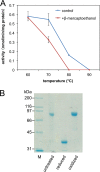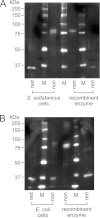In Vivo Formation of the Protein Disulfide Bond That Enhances the Thermostability of Diphosphomevalonate Decarboxylase, an Intracellular Enzyme from the Hyperthermophilic Archaeon Sulfolobus solfataricus
- PMID: 26303832
- PMCID: PMC4621072
- DOI: 10.1128/JB.00352-15
In Vivo Formation of the Protein Disulfide Bond That Enhances the Thermostability of Diphosphomevalonate Decarboxylase, an Intracellular Enzyme from the Hyperthermophilic Archaeon Sulfolobus solfataricus
Abstract
In the present study, the crystal structure of recombinant diphosphomevalonate decarboxylase from the hyperthermophilic archaeon Sulfolobus solfataricus was solved as the first example of an archaeal and thermophile-derived diphosphomevalonate decarboxylase. The enzyme forms a homodimer, as expected for most eukaryotic and bacterial orthologs. Interestingly, the subunits of the homodimer are connected via an intersubunit disulfide bond, which presumably formed during the purification process of the recombinant enzyme expressed in Escherichia coli. When mutagenesis replaced the disulfide-forming cysteine residue with serine, however, the thermostability of the enzyme was significantly lowered. In the presence of β-mercaptoethanol at a concentration where the disulfide bond was completely reduced, the wild-type enzyme was less stable to heat. Moreover, Western blot analysis combined with nonreducing SDS-PAGE of the whole cells of S. solfataricus proved that the disulfide bond was predominantly formed in the cells. These results suggest that the disulfide bond is required for the cytosolic enzyme to acquire further thermostability and to exert activity at the growth temperature of S. solfataricus.
Importance: This study is the first report to describe the crystal structures of archaeal diphosphomevalonate decarboxylase, an enzyme involved in the classical mevalonate pathway. A stability-conferring intersubunit disulfide bond is a remarkable feature that is not found in eukaryotic and bacterial orthologs. The evidence that the disulfide bond also is formed in S. solfataricus cells suggests its physiological importance.
Copyright © 2015, American Society for Microbiology. All Rights Reserved.
Figures





References
Publication types
MeSH terms
Substances
Associated data
- Actions
- Actions
LinkOut - more resources
Full Text Sources

